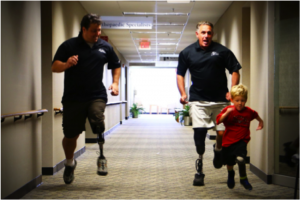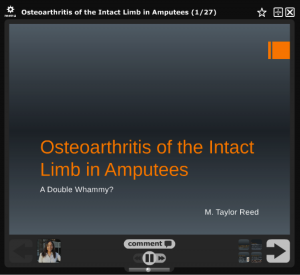Osteoarthritis in the Intact Limb of Lower Extremity Amputees
M. Taylor Reed
Overview
At present, there are 1.7 million individuals in the United States living with an amputation.2 There are another 185,000 amputations that occur every year with more than 500 amputations occurring each day.3 Lower extremity amputees face numerous musculoskeletal conditions just as the general population does. Osteoarthritis, osteopenia, osteoporosis, and low back pain are a few examples of musculoskeletal conditions that arise secondary to amputation.4 These same musculoskeletal conditions further compound disability in a population that may have limited mobility already.
For my capstone, I wanted to further explore some aspect of care in the amputee population. My interests in amputees was sparked when I had an in depth and honest conversation with a lower extremity amputee on the challenges of navigating life after amputation. My interests further grew during the amputee portion of the Musculoskeletal II course taken second year. After attending various amputee clinics, I realized physical therapy plays an important role beyond prosthetic training as these patients develop additional conditions throughout life. For this project, I focused on osteoarthritis as research shows it is a common condition in amputees with long-term prosthetic use.4 Further, research shows osteoarthritis is more prevalent in lower extremity amputees than in the general population.5-7 After sifting through the research and discussing the lack of confidence in treating amputees with my classmates, I decided I wanted to expand on this topic for my capstone by creating an educational piece.
Research
During the Advanced Orthopedic elective, I chose to investigate osteoarthritis in amputees for my course project. The preliminary research from my initial project was further expanded on for this Capstone. My review of the current evidence and literature investigated the prevalence of osteoarthritis in amputees compared to the general population, etiology, contributing factors, and preventative treatments for osteoarthritis specific to amputees. In my research, I found a number of studies discussing various components of osteoarthritis in amputees but nothing that examined the information collectively. Therefore, I have focused my efforts on creating a Literature Review to present the information I have found in a more comprehensive manner.
Products
My purpose for this capstone was to create a voicethread presentation, Osteoarthritis in the Intact Limb of Amputees, to be completed by UNC DPT students during the amputee portion of the Musculoskeletal II course of second year with the goal of expanding their knowledge on amputees and osteoarthritis. Students will take a brief pre-test prior to completing the voicethread followed by a brief post-test to assess what they have learned.
Additionally, I wanted to provide students and clinicians with a resource specifically for their amputee patients with osteoarthritis. I have created the Patient Pamphlet with resources specifically for New Bern, NC as well as a second Patient Pamphlet with the Resources section left blank. My intent is that students and therapist will provide resources specific to their community in the blank space to tailor the pamphlet to their patients. Here are the Resources for the patient pamphlet.
A Special Thanks and Feedback
I would like to take this time to thank my committee members, Dennis Bongiorni and Jon Hacke, for their valuable feedback throughout this process. I would also like to thank my capstone advisor, Mike Gross, for his continued guidance and support from the conception of this Capstone in Advanced Orthopedics.
Lastly, I would like to say thank you for visiting my capstone website. I would greatly appreciate any feedback on this project as I intend to use these products beyond graduation. Please feel free to email me with feedback and suggestions at meredith_reed@med.unc.edu or via the comment feature below.
Reference:
1. Kenny orthopedics: Prosthetics and orthotics. Kenny Orthopedics: Prosthetics and Orthotics Web site. http://www.kenneyorthopedics.com/storage/images/walking2.jpg. Updated 2014. Accessed 04/10, 2014.
2. Amputee statistics. Statistics Brain Web site. http://www.statisticbrain.com/amputee-statistics/. Published July 28, 2013. Updated 2013. Accessed Sept 16, 2013.
3. Limb loss resource center: Limb loss statistics. Amputee Coalition Web site. http://www.amputee-coalition.org/limb-loss-resource-center/limb-loss-statistics/index.html. Updated 2013. Accessed Sept 16, 2013.
4. Gailey R, Allen K, Castles J, Kucharik J, Roeder M. Review of secondary physical conditions associated with lower-limb amputation and long-term prosthesis use. Journal of Rehabilitation Research & Development. 2008;45(1):15-29. https://auth.lib.unc.edu/ezproxy_auth.php?url=http://search.ebscohost.com/login.aspx?direct=true&db=s3h&AN=31638470&site=ehost-live&scope=site.
5. Struyf P. The prevalence of osteoarthritis of the intact hip and knee among traumatic leg amputees. Arch Phys Med Rehabil. 2009;90(3):440.
6. Burke M. Bone and joint changes in lower limb amputees. Ann Rheum Dis. 1978;37(3):252.
7. Kulkarni J, Adams J, Thomas E, Silman A. Association between amputation, arthritis and osteopenia in british male war veterans with major lower limb amputations. Clin Rehabil. 1998;12(4):348-353. https://auth.lib.unc.edu/ezproxy_auth.php?url=http://search.ebscohost.com/login.aspx?direct=true&db=s3h&AN=5855196&site=ehost-live&scope=site.



4 Responses to “Osteoarthritis in the Intact Limb of Lower Extremity Amputees”
Taylor
Thanks for your comments Michael!
My capstone will actually be a module in the Musculoskeletal course in the upcoming Fall so I have not received any feedback other than my committee members and a few classmates. I look forward to checking the survey site once students begin taking the pre and post tests to see what they’ve learned.
As a student, I have definitely experienced the “pre-test anxiety” knowing it will not be graded. That being said, I also appreciate the instant feedback the post-test offers the audience on what they have learned from the presentation.
As far as a voiccethread versus a lecture/inservice component, this is my first time creating a voicethread. Of course it has pros and cons. While I do miss the personal interaction of face-to-face presentations and the discussion that follows, I love being able to rewind during a voicethread if I need clarity on a topic. In the Adv Ortho elective, I did this frequently and felt I learned more “during” the lecture than I would in a classroom setting (which may be specific to my learning style). I also like that this voicethread can be used in the amputee module long after I have graduated for students or in a clinical setting for practicing therapists.
Taylor
Michael Tighe
Dear Taylor:
I really like the idea, and the layout, of your pre- and post-test for your voice thread. I took the tests, myself, and got an 8/8 on the post-test (I missed questions 6 &8 on the pre-test). I thought they were good questions, and relevant to the topic at hand.
I have done the same thing before in-services and presentations I have given on lab values and their implications for PT practice. It is curious how a pre-test seems to elicit groans and increased anxiety in a group (even if you explain that the test is NOT being graded or sent to their supervisors! Did you have the same reaction from your participants?) A post-test demonstrates immediately to your audience how much they have learned from your instruction.
How did you find doing a voice thread versus a lecture or verbal instruction to a live audience? Did you find it difficult not having immediate feedback as you spoke (for example, the lost eyes of a participant telling you right away if they are “getting” what you are saying)?
Michael Tighe
Taylor Reed
Austin,
Thank you for your comments. Amputees commonly have osteoarthritis in their intact limb as I discussed in my capstone but they also often have osteoporosis in the residual limb. I intend to eventually expand on this project to include osteoporosis of the residual limb.
I did not come across any upper extremity literature as I was focused on the lower extremity with all of my searches. But you raise a great question. I certainly think it is feasible for the intact limb of upper extremity amputees to have OA from increase use and increase forces across the joint. Maybe I’ll expand on this project to include upper extremity amputees as well.
As far as amputees having increased risks associated with joint replacements I think that will depend on the reason for amputation. A majority of amputations are secondary to vascular conditions, which may create issues during surgery or in the healing process. However, I did not find anything that addressed that specifically.
Glad you found this helpful!
Taylor
Austin Leedy
Wow, Taylor!
I am truly impressed with all of your hard work and appreciate how passionate I can see you are about this topic. First off, I am very jealous of the DPT students to come because I feel this Voicethread would have really supplemented my education during this section of Musculoskeletal II. Your Voicethread is very well organized and easy to follow and your explanations were delivered well. For instance, it was very beneficial to me that you reviewed normal gait moments prior to discussing the gait moments that individuals with amputations may demonstrate. Your patient hand out is also visually appealing, easy to read, and easy to comprehend.
This may seem obvious to most, but I was shocked learn that the osteoarthritis is commonly found in the intact limb. Prior to viewing your information, I imagined the osteoarthritis on the residual limb side of the body at the joint superior to the amputation. I think that is a common misconception in general for many inexperienced therapists working with the amputation population—we go directly to the residual limb and forget to also give equal attention to the intact limb. I know your research focused on the lower extremity, but seeming as the only patient with an amputation I have ever treated had a transhumeral amputation, I was curious to know if you came across any literature stating if there is an increase in joint OA in the intact UE as well? I know the upper extremity experiences less weight-bearing forces, but applying similar principles of increased use of the intact UE limb, it seems possible.
Finally, your prevention/treatment section was very conclusive and I had no idea that some of these interventions could be used (PNF, TKR, etc.) You stated in your PowerPoint that one potential treatment is a total joint replacement and modifications to the rehabilitation plan of care may be needed afterwards, however, does an amputee patient face increased medical/musculoskeletal risks compared to another patient receiving a TKR?
I have downloaded/saved your information as it will be very helpful for me if/when I treat my first patients with amputations! Great job, Taylor!
Austin